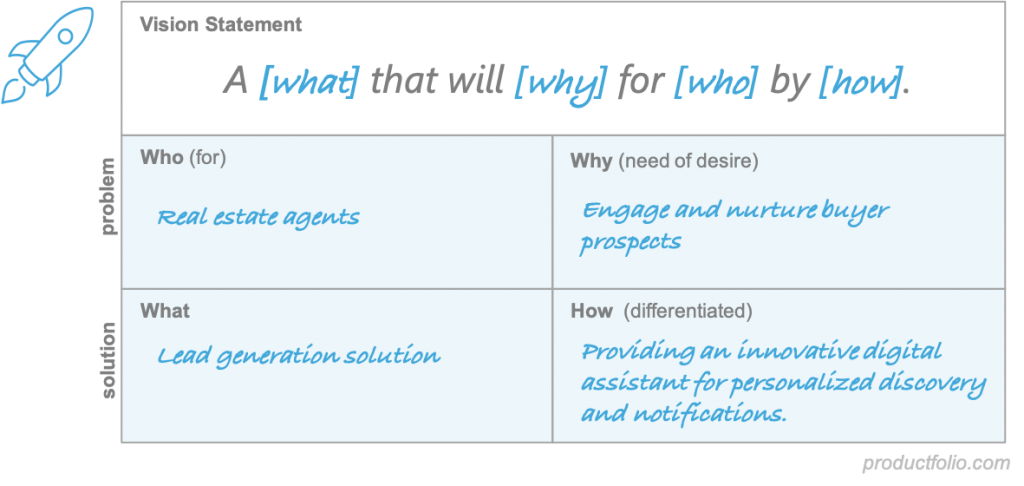What is a Product Vision?
A product vision is a description of what you hope to achieve with your product. It is a product’s targeted overall mission in the long term or its intended future state. Typically, it is presented as a statement known as the product vision statement.

A product vision provides direction for the product team, without which everything may be done haphazardly. You can think of it as the “North Star” of product strategy. It spells out the “what” and “why” of a product while also identifying intended users.
Alignment is one of the reasons why vision statements are created. The product vision makes it easy to know why the product is worth creating and what it can offer your company. It, therefore, influences decisions that would be taken as regards development.
The product vision is a prerequisite for the product roadmap. It links to the overall mission or goals of an organization.
Product Vision and Product Strategy
The product vision is related to the product strategy, but they are not the same. It is critical to take note of the difference between the two to make the most out of them.
A product vision points to the direction of the product while the strategy deals with how you can get there. So, essentially, the former is a requirement for the latter – without a vision, you have nothing to work towards.
The product strategy is vital for every product and the product vision is one of its three key components. The other two parts are the prioritization objectives and the product roadmap.
The relationship between the two is such that your product strategy can change while your product vision remains practically the same.
How Do You Create an Effective Product Vision?
The process of creating your product vision statement should involve the following key steps:
- Researching your market to understand your customers and their needs
- Identifying the value you hope for your product to deliver
- Working with other stakeholders to come up with an inspiring vision
Neal Cabage provides a good product vision template that should make the creation of effectual vision statements seamless. This template requires you to provide answers to the following questions:
- Who – Identify the people you want to build the product for.
- Why – For what reason(s) do you think the solution is worth providing? Why would your target market buy it?
- What – Determine or consider the sort of product that you want to build or have developed.
- How – In what ways does your product satisfy the observed needs or desires? What is its main value proposition?
With answers to these questions ready, you can proceed to create your product vision statement. Cabage suggests this format for putting together a concise and effective statement:
“A [what] that will [why] for [who] by [how].”
You replace the “what,” “why,” “who,” and “how” with the answers that you have come up with.
Who Defines Product Vision?
The vision or goals of a company influences the product vision. In other words, the direction an organization is heading toward influences what paths products should follow to avoid derailment.
Product leaders, such as the vice president of product or the chief product officer (CPO), are often responsible for the product vision. This, however, doesn’t mean that these individuals are exclusively in charge of its definition.
The product vision guides the work of the development team and guides interaction with different stakeholders. It is only reasonable, therefore, to include the different parties in the process of defining the vision.
Product managers should play an active part in the definition. This is because they will take a central role in its execution and in calling the attention of everyone to it.
How to Make Your Product Vision Effective
Keep it simple and short
Concise product vision statements have proven in many cases to be highly effective. For instance, Google’s vision statement was, “To provide access to the world’s information with one click.”
Your product vision should ideally be easy to say, understand, and memorize. You don’t need to provide the full details – your product strategy and other documents such as the backlog will do that. Keep it within a single sentence if possible.
Make it inspiring
The best product vision statements are those that make it easier to keep everyone inspired and motivated. People are more likely to feel inspired when the vision is to create something they care about or that solves a problem for others and not just to make money.
As Steve Jobs once said, “If you are working on something exciting that you really care about, you don’t have to be pushed. The vision pulls you.”
Share it
You need people to make your product vision a reality. It is, therefore, critical to share your vision with relevant teams and stakeholders. This doesn’t mean simply telling them what you aim to achieve with your product but making them a part of the process.
This brings us back to the need for the vision statement creation to be collaborative. When people have a say in what to achieve, they are more likely to give in their best to ensure success.